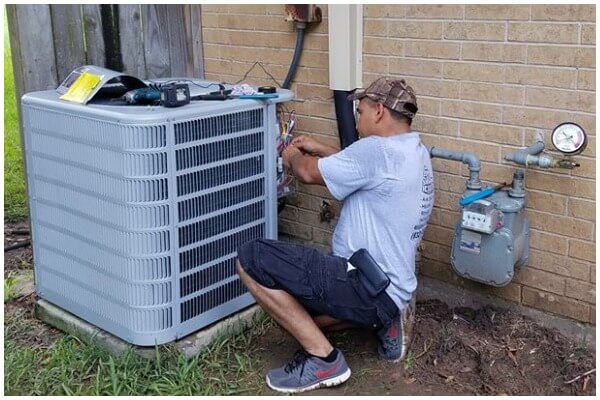Mold in HVAC systems can cause serious health and safety concerns. Mold is a fungus growing in damp, dark areas, making HVAC systems the perfect breeding ground for it to thrive. In addition to causing unpleasant odors and reducing indoor air quality, mold can trigger allergic reactions or asthma attacks.
Moreover, if left untreated, mold growth can damage your HVAC system. Knowing how to identify and prevent HVAC mold is essential for protecting your home from its potential adverse effects. With the right knowledge and maintenance, you can effectively manage mold risks around your home before they become a major problem.

How does the mold get into your HVAC system?
Mold can enter an HVAC system in several ways. The most common source of mold is from the air outside, especially during humid or wet weather. Spores from outdoor mold are easily spread by wind and can find their way into your home through open windows, doorways, and other openings. These spores can then settle in places like the intake vents of your HVAC system. Additionally, moisture accumulation inside the ductwork caused by condensation or leaky pipes or valves can also create favorable conditions for mold growth.
When your AC runs, it will suck in air that contains these spores and circulate them throughout the house, leading to potential health risks associated with exposure to airborne mold particles. In addition to this direct infiltration, mold can enter HVAC systems via the indoor air being cooled or heated.
Dust or debris containing mold spores can accumulate in filters over time and eventually get pulled into the system when it switches on. Poor ventilation in damp rooms can also contribute to moisture buildup and encourage the growth of mold inside your HVAC system.
Keeping the mold out: The best way to never deal with mold in your home is to prevent a possible mold overgrowth within your HVAC system. Here are ten things you can do to prevent a mold outbreak in your HVAC system.
1. Regular System Maintenance: One of the best ways to prevent mold from growing in your HVAC system is to have regular maintenance and inspections done by a qualified technician. Through regular check-ups, they can identify potential water leaks or other sources of moisture that may lead to mold growth. This includes inspecting ductwork for signs of condensation and checking for any blockages in the vents. They can also suggest effective cleaning solutions against mold spores and assess whether parts need replacement or repair.
2. Clean and Replace Air Filters: As previously mentioned, dust and debris which contain mold spores can accumulate in air filters over time. To reduce the risk of contamination from these particles, it’s important to clean and replace your air filters regularly. This will ensure that the air circulating through your system is as clean and mold-free as possible.
Also Read: Reasons Why Your Small Home Needs Proper HVAC System
3. Improve Ventilation: Poor ventilation in damp areas of your home can lead to moisture accumulation, making it an ideal environment for mold growth. Increasing the airflow in such rooms by opening windows or installing extractor fans can help reduce indoor humidity levels and prevent condensation from forming inside HVAC systems.
4. Use a Dehumidifier: Using a dehumidifier to regulate indoor humidity levels is another effective way to reduce the risk of mold growth in your home. These devices absorb excess moisture from the air and discharge it outside, preventing condensation from accumulating in the ducts of your HVAC system.
5. Install a UV Light: Ultraviolet (UV) light has been found to be very effective at killing mold spores and other microorganisms that can contaminate your home’s air. Installing a UV light in the air handling unit of your HVAC system can help reduce the risk of contamination from these particles and promote healthier indoor air quality.
6. Clean Ductwork: Regularly cleaning and disinfecting the inside ductwork is another essential step for preventing mold growth within your HVAC system. This involves using a vacuum cleaner or specialized cleaning tools to remove any dust or debris buildup from within the ducts, as well as applying an anti-microbial cleaning solution to destroy any mold spores that may be present.
7. Use Air Purifiers: Installing air purifiers with HEPA filters in your home can help eliminate airborne contaminants such as dust, pollen, and mold spores from the air. These devices are designed to effectively capture particles as small as 0.3 microns in size, meaning they can help make sure that only clean air is being circulated through your HVAC system.
8. Repair Leaks or Drips: If a water leak or drip has been identified within your HVAC system, it’s important to repair it immediately to prevent the formation of condensation and reduce the risk of mold growth. This could involve replacing a damaged pipe or gasket, as well as installing additional insulation to prevent future leaks from occurring.
Also Read: How to Prevent & Get Rid of Mold in the Bathroom: 5 Tips
9. Increase Temperature: Increasing your home’s temperature is another way to reduce condensation and the risk of mold growth in your HVAC system. During colder months, setting the thermostat at a higher temperature can help keep indoor humidity levels low and discourage moisture accumulation within the ducts.
10. Use Mold-Resistant Insulation: Mold-resistant insulation in areas where moisture may accumulate, such as basements or attics, can also help inhibit mold formation inside your HVAC system. This type of insulation is specifically designed to resist water damage and provide an extra layer of protection against potential sources of contamination.
By following these tips, you can help reduce the risk of mold growth in your HVAC system and ensure that your home stays healthy and safe for everyone who lives there. For more information about preventing HVAC mold, speak with a certified professional or contact your local air quality specialist.